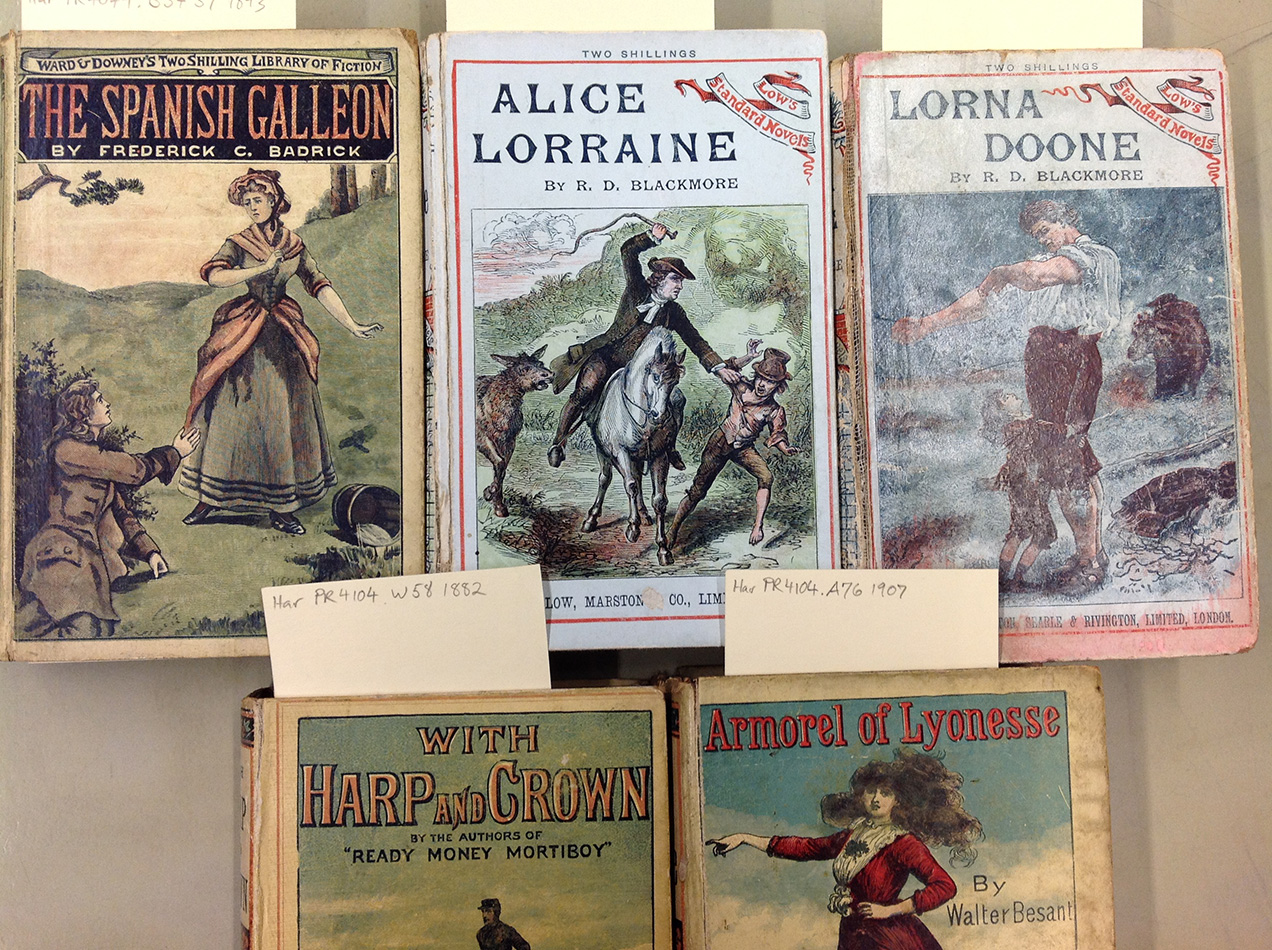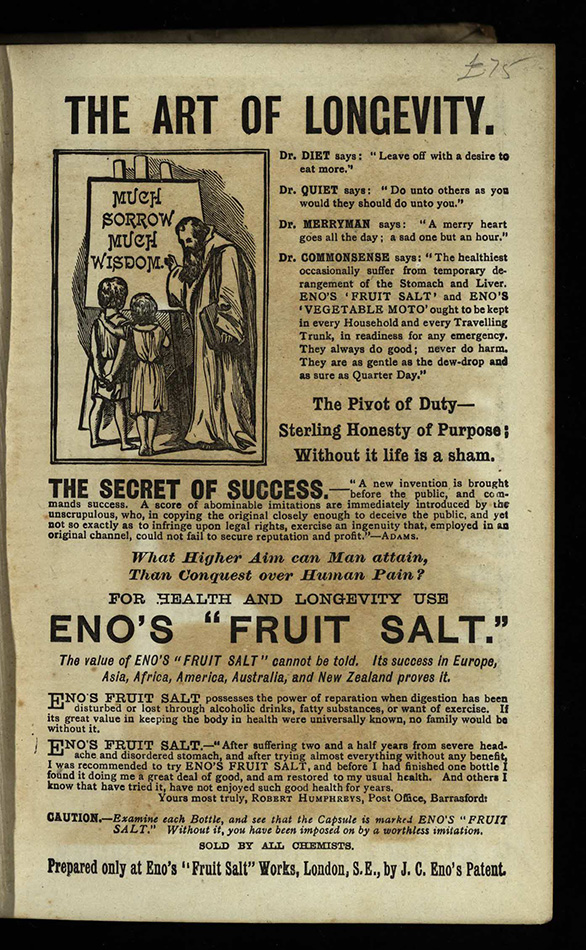Emollient Milk, Soap and Luxury Products: Advertising Consumer Goods in late Victorian and early Edwardian Britain

The industrial revolution and the emergence of the middle class in Victorian Britain led to an unprecedented rise of supply and demand for consumer goods. To promote their products, small entrepreneurs started to adopt new marketing strategies like advertising. As a result, advertisements were increasingly common in newspapers, magazines and books. To maximise the effectiveness of their advertisements and ensure that they would reach targeted customer groups, advertisements for consumer products were usually printed in leisure reading such as novels. This blog post features a few examples from novels published in the late nineteenth and early twentieth centuries that are part of the personal collection of former Rare Books Librarian Geoff Hargreaves, gifted to the University by his widow, Jan Hargreaves, in 2012. These adverts give an insight into the consumer culture of late Victorian and early Edwardian Britain.

Healthcare products were becoming very popular among the middle class who were increasingly willing and financially able to improve their lifestyle and wellbeing. In this advertisement, M. Beetham & Son boasted about having the best emollient milk for the skin. It highlighted that the milk could keep the skin “soft, smooth and white”. The Victorians and early Edwardians loved pale skin. It was a sign of wealth, indicating that women could afford not to spend hours working outdoors.

The rise of modern medicine and pharmacy not only helped cure previously fatal diseases, but also led to the emergence of healthcare products that aimed at improving health. James Crossley Eno, a native of Newcastle, invented his own brand of fruit salt in the 1850s. His product was most famous for reliving stomach and liver pain, and travel and sea-sickness. Going a step further, this advertisement boasted of the effectiveness of his fruit salt in maintaining health and longevity. The numerous quotes, some fictional and some attributed, were reinforced by the illustration wherein an old man, representing longevity, teaches children the ‘art of longevity’. It was part of an ongoing campaign reflecting Eno’s fondness for quotations, rhyming slogans, and use of full-page adverts. His approach was successful, with the brand achieving worldwide recognition. Eno’s fruit salt is still being manufactured today.

A discussion of Victorian healthcare and beauty is incomplete without mentioning Rowland’s products, for they were very popular among women in the Victorian age seeking to slow down the ageing process. This advertisement promoted Rowland’s Kalydor, Macassar oil and Odonto, which were healthcare treatments for skin, hair and teeth respectively. While it might seem bizarre to us, it also highlighted the products’ non-poisonous nature – for beauty, some Victorian women risked ruining their heath by taking poisonous but effective drugs. The readers of this advertising strand on our blog are already familiar with Rowland’s products: they have been an almost constant feature so far.

Another interesting advertisement shows a number of elegantly dressed people and children meeting each other in front of a poster about Pears soap. Londoner Andrew Pears started his business selling the world’s first mass-produced translucent soap in 1807. Under the management of Thomas J Barratt, often dubbed the “father of modern advertising”, the company was responsible for spearheading advertising trends and numerous innovations in brand marketing. In this advert, he used a clever catch phrase to attract the attention of the audience.

Luxury and oriental goods were also popular among the Victorian middle class. With the success of its imperial project and expansion of the British Empire, selected oriental products and decorations were imported into the imperial metropolis and fascinated Victorians. This piece by Oetzmann & Co., a furniture manufacturer and retailer in London since 1848, advertised its business with four illustrations of furniture. With the extensive use of bamboo, oriental ornaments and even tortoise-shell, a popular decorative element in China and Japan, the four pieces of furniture were themselves highly oriental in their design. These pieces were normally bought to decorate the parlour, an important room used to entertain and impress guests in the Victorian era.

Similarly, this lavish advertisement promoting oriental products available from Procter & Co., importers of Indian Gold and Silverware Jewellery, must have impressing readers with its three illustrations. After 1882 the company continued to grow and later participated at the Manchester Exhibition in 1887, and the Antwerp Exhibition in 1894. Together, these advertisements provide an interesting insight into late Victorian and early Edwardian consumer culture and lifestyle, marked by the popularisation among the newly formed middle class of healthcare products and luxury goods that were previously exclusive to elites.
Joseph Yu
Lighting the Past cataloguer
Joseph, a cataloguer in the Lighting the Past team, is a final year undergraduate student pursuing an MA (Hons) in International Relations and Modern History. Hailing from Hong Kong, Joseph’s research interests lie mainly on transnational histories and security issues of East and Southeast Asia, but he is equally fascinated by the rise of consumer culture in Victorian Britain.
It's always interesting to notice so many changes in everything since 19th century.
As a St Andrews alum, art history, and antique "superfan" I was thrilled to stumble across this blog. Fantastic, and so interesting!
I request permission to use the advert. Eno’s Fruit Salt, in Spanish Galleon (1893). Bar PR4049.B34S7 1983 From : “Emollient milk, Soap and Luxury Products. Advertising Consumer Goods in Later Victorian Times” This is part of a heritage project undertaken by the Lakenheath Heritage Group and the Lakenheath Parish Council, Lakenheath, Suffolk.This is a non profit making Parish Project. I hope for your permission, David Jones, Chair, Lakenheath Heritage Group.